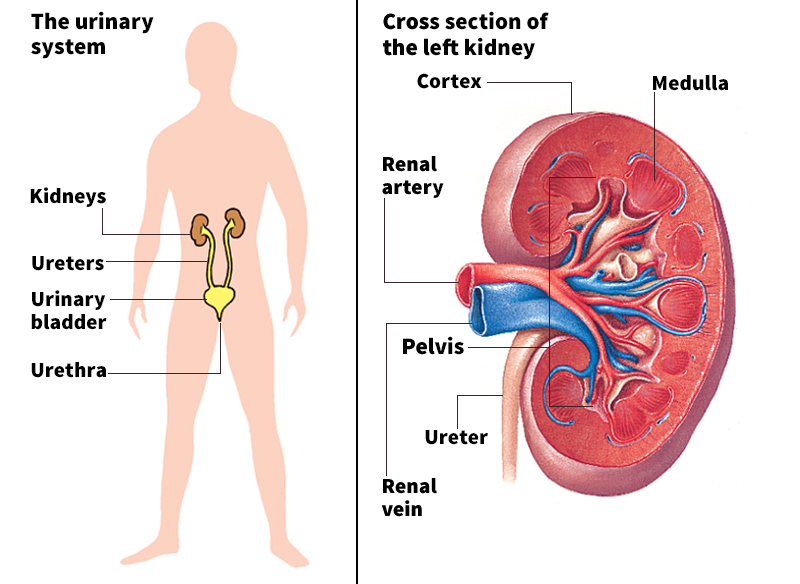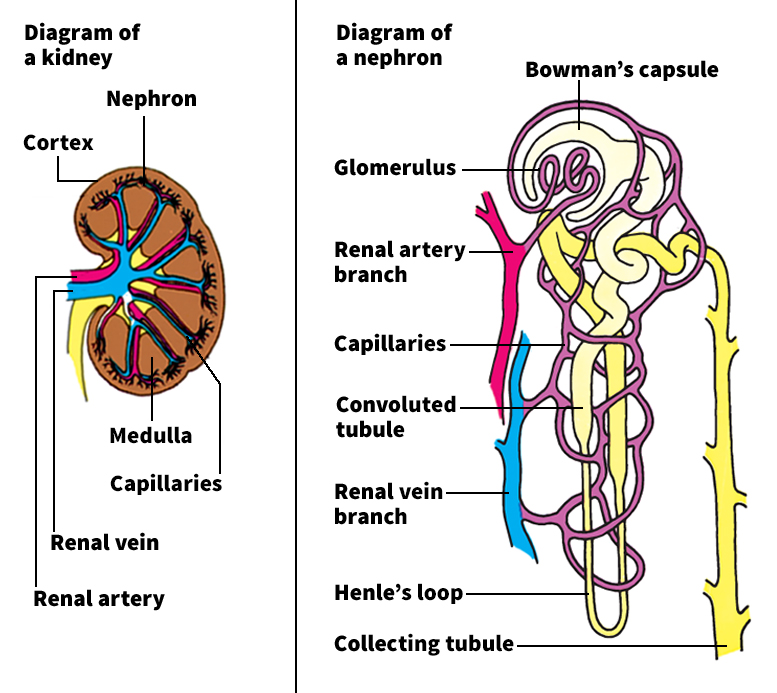Kidney is a complex organ in human beings and all other vertebrates. The two kidneys perform many vital functions, of which the most important is the production of urine. This fluid carries various waste materials out of the body. If the kidneys fail to function, poisons build up in the body, eventually causing death.

The kidneys look like purplish-brown kidney beans and are about the size of an adult’s fist. They lie below the middle of the back on each side of the spine. The right kidney, located under the liver, is a little lower than the left one. Some people are born with only one kidney. However, they are able to lead a normal life.
How the kidneys produce urine.
Human kidneys consist of three layers. These layers are, in order, the cortex on the outside of the organ, the medulla, and the pelvis. Blood flows into the medulla through the renal artery. In the medulla and cortex, the renal artery branches into increasingly smaller arteries. Each of these arteries ends in a blood filtration unit called a nephron. Two healthy kidneys contain a total of about 2 million nephrons, which filter about 500 gallons (1900 liters) of blood daily.

A nephron consists of a network of tiny blood vessels, the glomerulus, surrounded by Bowman’s capsule, a two-layer membrane that opens into a convoluted tubule. Pressure forces much of the blood plasma (fluid portion of the blood) through the glomerulus and into Bowman’s capsule. The resulting tubular fluid, which contains water and dissolved chemicals, then passes into the convoluted tubule.
The portion of the blood that remains in the glomerulus flows into small vessels called capillaries, which surround the convoluted tubule. As the tubular fluid flows through the tubule, substances needed by the body are absorbed by the cells of the tubule wall. These substances, which include amino acids, glucose, and about 99 percent of the water, then rejoin the blood in the capillaries. The capillaries return the blood to the heart by way of the renal vein.
Substances not absorbed in the tubule are wastes that the body cannot use. Other wastes are secreted into the tubular fluid by the tubular cells of the kidney. These various substances, which include ammonia, urea, uric acid, and excess water, make up urine. The urine passes from the convoluted tubules into larger collecting tubules and then into the pelvis layer of the kidney. A tube called the ureter carries urine from each kidney into the urinary bladder. Urine collects in the bladder until it passes out of the body through another tube, the urethra. Healthy kidneys produce from 1 to 2 quarts (0.95 to 1.9 liters) of urine daily.
Other functions of the kidneys.
In addition to producing urine, the kidneys secrete a hormone called erythropoietin, which controls the production of red blood cells. The kidneys convert vitamin D from an inactive to an active form. The active form is essential for normal bone development. The kidneys also help maintain the blood pressure of the body by releasing an enzyme called renin (see Hypertension (Causes)).
Kidney diseases.
If one kidney is lost in an accident or by disease, the other may enlarge and do the work of both. But if both kidneys are damaged or lost, waste materials accumulate in the body, causing death.
Kidney infection, called pyelonephritis, ranks as the most common kidney disease. Most cases result from infection that spreads upward from the bladder. Unless it is complicated by blockage of the urinary tract, pyelonephritis rarely leads to kidney failure.
The kidneys also can be damaged by antibodies produced to fight bacteria or viruses elsewhere in the body. Such reactions lead to inflammation of the glomerulus. This type of inflammation is called glomerulonephritis, formerly known as Bright’s disease.
Long-term or severe high blood pressure can seriously damage the kidneys, as can diabetes. Cysts, kidney stones, and tumors may block the flow of urine. The blocked urine can damage the kidneys by exerting pressure upon them, or it may lead to pyelonephritis. Kidney disorders may also result from birth defects, injuries, or poisoning, or as a side effect of certain medications.
Many people who have lost their kidneys or have suffered kidney damage are kept alive by a dialysis machine. A tube connects this machine to an artery in the patient’s arm. Blood flows into the machine, which removes wastes. Another tube carries the blood back into a vein in the arm. Patients generally undergo this process, called hemodialysis, for several hours, three times a week.
Some kidney patients can use ambulatory dialysis, a continuous procedure that does not involve being connected to a machine. In this process, a container of dialysis solution is emptied into the patient’s abdominal cavity through a permanently implanted tube. The solution remains there for several hours, picking up wastes from the bloodstream. The patient then drains the used solution and replaces it with a fresh supply.
Other kidney patients have their diseased kidneys replaced with healthy ones in a kidney transplant. A replacement organ from a close relative is desirable because it closely matches the patient’s tissues. But most replacement organs come from unrelated individuals who have died in accidents or from other causes. The patient’s body always attempts to reject these “foreign” organs. However, modern medicines are usually able to control the rejection process and protect the transplanted kidney.
